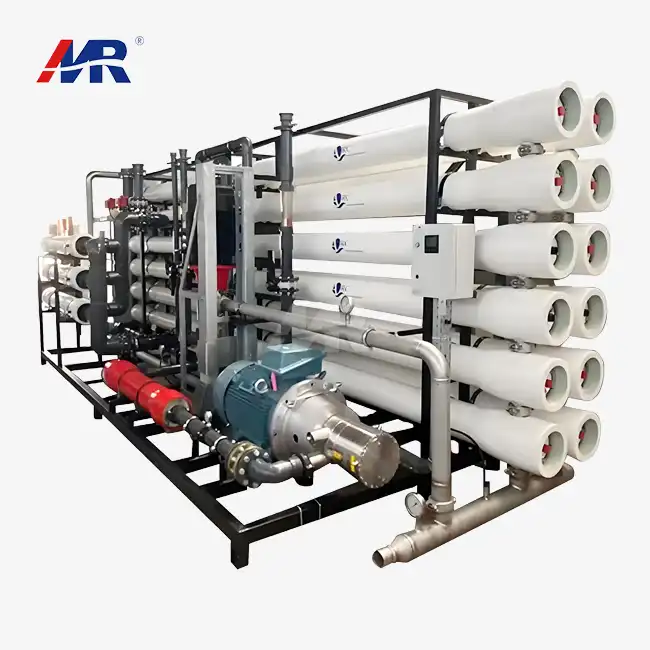Portable SWRO Units: When to Choose Containerized?
Containerized seawater desalination systems have gained popularity due to their numerous advantages in specific situations. These plug-and-play units are ideal for applications that require mobility, rapid deployment, or temporary water treatment solutions. Let's explore the scenarios where containerized systems shine:
Emergency Response and Disaster Relief
In the wake of natural disasters or humanitarian crises, containerized desalination units can be quickly transported to affected areas, providing a crucial source of clean water. Their self-contained nature allows for swift setup and operation, even in challenging environments with limited infrastructure.
Remote Locations and Offshore Applications
For isolated coastal communities, islands, or offshore platforms, containerized systems offer a compact solution that can be easily shipped and installed. These units are particularly valuable for oil and gas operations, military bases, and remote resorts where space is at a premium and logistical challenges are significant.
Pilot Projects and Temporary Installations
When evaluating the feasibility of a larger desalination project or addressing short-term water needs, containerized units provide an excellent option for pilot studies or temporary installations. Their modular nature allows for easy relocation or expansion as project requirements evolve.
Scalability Benefits of Modular Desalination Plants
While containerized systems excel in certain applications, modular desalination plants offer unique advantages in terms of scalability and long-term flexibility. These benefits make them particularly attractive for growing communities and industries with evolving water demands.
Adaptable Capacity
Modular SWRO plants can be designed with the future in mind, allowing for incremental capacity increases as water needs grow. This approach enables organizations to optimize their initial investment while maintaining the ability to expand production over time. By adding additional modules or upgrading existing components, plant capacity can be seamlessly increased without major disruptions to operations.
Optimized Layout and Integration
Unlike the fixed configuration of containerized units, modular desalination plants offer greater flexibility in terms of layout and integration with existing infrastructure. This adaptability allows for more efficient use of available space and improved synergy with other water treatment processes or power generation facilities.
Customization and Technology Updates
Modular systems provide the advantage of easier customization and technology upgrades. As advancements in membrane technology and energy recovery systems emerge, individual modules can be updated or replaced without overhauling the entire plant. This flexibility ensures that the desalination facility remains at the forefront of efficiency and performance throughout its operational life.
Installation Time & Cost: Containerized vs. Modular
When comparing containerized and modular desalination systems, installation time and cost are critical factors that can significantly impact project feasibility and return on investment. Let's examine how these two approaches differ in terms of implementation:
Containerized Systems: Rapid Deployment
Containerized seawater desalination plants offer several advantages in terms of installation:
- Shorter on-site construction time due to pre-assembly and testing at the factory
- Reduced need for extensive civil works and site preparation
- Lower initial labor costs for installation and commissioning
- Quicker time-to-operation, often within weeks of delivery
However, it's important to note that containerized systems may have higher upfront costs due to the specialized manufacturing and transportation requirements.
Modular Systems: Long-term Cost-effectiveness
Modular desalination plants typically require more time for initial installation but offer benefits in other areas:
- Lower per-unit capacity costs, especially for larger-scale installations
- Reduced transportation costs compared to fully assembled containerized units
- Greater flexibility in sourcing components from multiple suppliers
- Easier integration with existing infrastructure and utilities
While the initial installation process may be longer, modular systems often prove more cost-effective over the long term, particularly for permanent installations with potential for future expansion.
Considerations for Total Cost of Ownership
When evaluating installation time and cost, it's crucial to consider the total cost of ownership over the system's lifespan. Factors such as energy efficiency, maintenance requirements, and scalability can significantly impact long-term operational expenses. Both containerized and modular systems can be designed to optimize these factors, but the specific project requirements and local conditions will ultimately determine the most cost-effective solution.
Conclusion
In conclusion, the choice between containerized and modular desalination systems depends on a variety of factors, including project scale, timeline, location, and future growth projections. Containerized units excel in rapid deployment and portability, making them ideal for temporary or emergency applications. Modular plants offer greater scalability and long-term flexibility, suited for permanent installations with evolving capacity needs.
As water scarcity continues to be a global concern, innovative desalination technologies play a crucial role in ensuring sustainable water supplies for coastal communities and industries. Whether opting for a containerized or modular approach, modern seawater desalination plant systems offer efficient and reliable solutions for transforming seawater into a valuable freshwater resource.
Are you considering a seawater desalination project for your organization? Look no further than Guangdong Morui Environmental Technology Co., Ltd. As a leading provider of water treatment solutions, we offer cutting-edge desalination systems tailored to your specific needs. Our comprehensive services include equipment supply, installation, commissioning, and ongoing support to ensure worry-free operation.
With our state-of-the-art membrane production facility and partnerships with top industry brands, we deliver high-quality, efficient desalination solutions for various applications. From coastal municipalities to offshore platforms and industrial facilities, our expert team is ready to help you overcome water scarcity challenges. Don't let water shortages limit your potential. Contact us today at benson@guangdongmorui.com to explore how our innovative desalination systems can secure your water future.
References
1. Johnson, A. R., & Smith, B. T. (2021). Comparative Analysis of Containerized and Modular Desalination Systems for Coastal Applications. Journal of Water Resources Management, 35(4), 789-805.
2. Martínez-Alvarez, V., et al. (2020). Seawater Desalination for Agriculture: State of the Art and Future Prospects. Desalination, 491, 114559.
3. Gude, V. G. (2019). Emerging Technologies for Sustainable Desalination Handbook. Butterworth-Heinemann.
4. Peñate, B., & García-Rodríguez, L. (2022). Current Trends and Future Prospects in the Design of Seawater Reverse Osmosis Desalination Technology. Desalination, 495, 114659.
5. Al-Karaghouli, A., & Kazmerski, L. L. (2018). Energy Consumption and Water Production Cost of Conventional and Renewable-Energy-Powered Desalination Processes. Renewable and Sustainable Energy Reviews, 24, 343-356.
6. Ghaffour, N., et al. (2023). Desalination Technologies: Current Status and Future Prospects. Water Research, 215, 119228.

_1745823981883.webp)


